Advanced¶
The select menu in edit mode contains additional tool for selecting components:
- Sharp Edges
- This tool selects all edges between two faces forming an angle greater than the angle value, Where an increasing angle selects sharper edges.
- Linked Flat Faces
Ctrl-Shift-Alt-F - Select connected faces based on a threshold of the angle between them. This is useful for selecting faces that are planar.
- Mirror
- Select mesh items at the mirrored location across the chosen axis.
- Side of Active
- Selects all vertices on the mesh in a single axis relative to the active vertex. In Vertex selection mode only.
- Linked
- Selects all components that are connected to the current selection. (see Select Linked)
Checker Deselect¶
Reference
This tool applies a alternating selected/deselected checker pattern. This only works if you already have more than one mesh element selected.
- Nth Selection
- Using the current selection, it will deselected every nth element.
- Skip
- Number of steps to skip the pattern and keep selected.
- Offset
- Offsets at what point to start at.
Select All by Traits¶
- Non Manifold
Ctrl-Shift-Alt-M Selects the non-manifold geometry of a mesh. This entry is available when editing a mesh, in Vertex and Edge selection modes only. The Operator panel provides several selection options:
- Extend
- Lets you extend the current selection.
- Wire
- Selects all the edges that do not belong to any face.
- Boundaries
- Selects edges in boundaries and holes.
- Multiple Faces
- Selects edges that belong to three or more faces.
- Non Contiguous
- Selects edges that belong to exactly two faces with opposite normals.
- Vertices
- Selects vertices that belong to wire and multiple face edges, isolated vertices, and vertices that belong to non adjoining faces.
- Interior Faces
- Selects faces where all edges have more than two faces.
- Select Faces by Sides
- Selects all faces that have a specified number of edges.
- Loose Geometry
- Selects all vertices or edges that do not form part of a face.
- Ungrouped Vertices
- Selects all vertices which are not part of a vertex group.
Select Linked¶
Reference
Ctrl-LSelect geometry connected to already selected elements. This is often useful when a mesh has disconnected, overlapping parts, where isolating it any other way would be tedious.
To give more control, you can also enable delimiters in the Operator panel, so the selection is constrained by seams, sharp-edges, materials or UV islands.
With Pick Linked you can also select connected geometry directly under the cursor,
using the L shortcut to select or Shift-L to deselect linked.
This works differently in that it uses the geometry under the cursor instead of the existing selection.
Select Similar¶
Reference
Shift-GSelect geometry that have similar certain properties to the ones selected, based on a threshold that can be set in tool properties after activating the tool. Tool options change depending on the selection mode:
- Vertex Selection Mode:
- Normal
- Selects all vertices that have normals pointing in similar directions to those currently selected.
- Amount of Adjacent Faces
- Selects all vertices that have the same number of faces connected to them.
- Vertex Groups
- Selects all vertices in the same vertex group.
- Amount of Connecting Edges
- Selects all vertices that have the same number of edges connected to them.
- Face Regions
- Select matching features on a mesh that has multiple similar areas based on the topology.
- Edge Selection Mode:
- Length
- Selects all edges that have a similar length as those already selected.
- Direction
- Selects all edges that have a similar direction (angle) as those already selected.
- Amount of Faces Around an Edge
- Selects all edges that belong to the same number of faces.
- Face Angles
- Selects all edges that are between two faces forming a similar angle, as with those already selected.
- Crease
- Selects all edges that have a similar Crease value as those already selected.
- Bevel
- Selects all edges that have the same Bevel Weight as those already selected.
- Seam
- Selects all edges that have the same Seam state as those already selected. Seam is a true/false setting used in UV-texturing.
- Sharpness
- Selects all edges that have the same Sharp state as those already selected. Sharp is a true/false setting (a flag) used by the Edge Split Modifier.
- Face Selection Mode:
- Material
- Selects all faces that use the same material as those already selected.
- Image
- Selects all faces that use the same UV-texture as those already selected (see UV-texturing pages).
- Area
- Selects all faces that have a similar area as those already selected.
- Polygon Sides
- Selects all faces that have the same number of edges.
- Perimeter
- Selects all faces that have a similar perimeter (added values of its edge lengths).
- Normal
- Selects all faces that have a similar normal as those selected. This is a way to select faces that have the same orientation (angle).
- Co-planar
- Selects all faces that are (nearly) in the same plane as those selected.
More/Less¶
- More
Ctrl-NumpadPlus - Expands the selection to the adjacent elements of the selection type.
- Less
Ctrl-NumpadMinus - Contracts the selection from the adjacent elements of the selection type.
- Next Active
Ctrl-Shift-NumpadPlus - This uses selection history to select the next vertex/edge/face based on surrounding topology.
- Previous Active
Ctrl-Shift-NumpadMinus - Select previous just removes the last selected element.
Select Loops¶
You can easily select loops of components:
Edge Loops¶
Reference
Alt-RMBHolding Alt while selecting an edge selects a loop of edges that are connected in
a line end to end, passing through the edge under the mouse pointer.
Holding Alt-Shift while clicking adds to the current selection.
Edge loops can also be selected based on an existing edge selection,
using either ,
or the Edge Loop Select option of the Edge Specials menu Ctrl-E.
Note
Vertex mode
In Vertex select mode, you can also select edge loops, by using the same hotkeys, and clicking on the edges (not on the vertices).
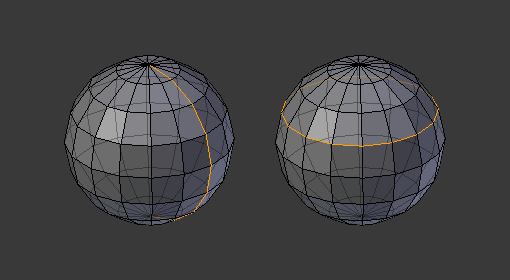
Longitudinal and latitudinal edge loops.
The left sphere shows an edge that was selected longitudinally. Notice how the loop is open. This is because the algorithm hit the vertices at the poles and terminated because the vertices at the pole connect to more than four edges. However, the right sphere shows an edge that was selected latitudinally and has formed a closed loop. This is because the algorithm hit the first edge that it started with.
Face Loops¶
Reference
Alt-RMBIn face select mode, holding Alt while selecting an edge selects a loop of
faces that are connected in a line end to end, along their opposite edges.
In vertex select mode,
the same can be accomplished by using Ctrl-Alt to select an edge,
which selects the face loop implicitly.
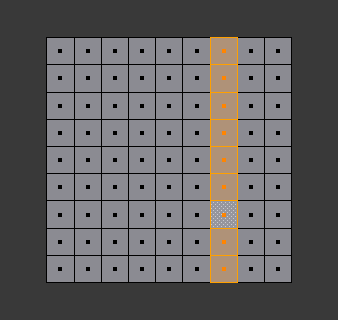
Face loop selection.
This face loop was selected by clicking with Alt-RMB on an edge,
in face select mode.
The loop extends perpendicular from the edge that was selected.
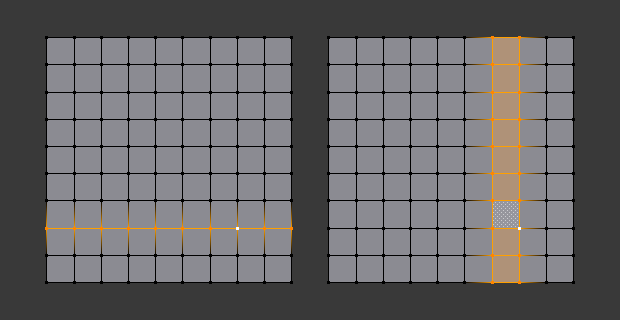
Alt versus Ctrl-Alt in vertex select mode.
A face loop can also be selected in Vertex select mode.
Technically Ctrl-Alt-RMB will select an Edge Ring,
however, in Vertex select mode, selecting an Edge Ring implicitly
selects a Face Loop since selecting opposite edges of a face implicitly selects
the entire face.
Edge Boundary¶
Reference
Alt-RMBLoop-select on edge boundaries.
To extend the selection to all boundaries if the current boundary is already selected
use Alt-RMB again.
Edge Ring¶
Reference
Ctrl-Alt-RMBIn Edge select mode, holding Ctrl-Alt
while selecting an edge (or two vertices) selects a sequence of edges that are not connected,
but on opposite sides to each other continuing along a face loop.
As with edge loops, you can also select edge rings based on current selection,
using either ,
or the Edge Ring Select option of the Edge Specials menu Ctrl-E.
Note
Vertex mode
In Vertex select mode, you can use the same hotkeys when clicking on the edges (not on the vertices), but this will directly select the corresponding face loop...
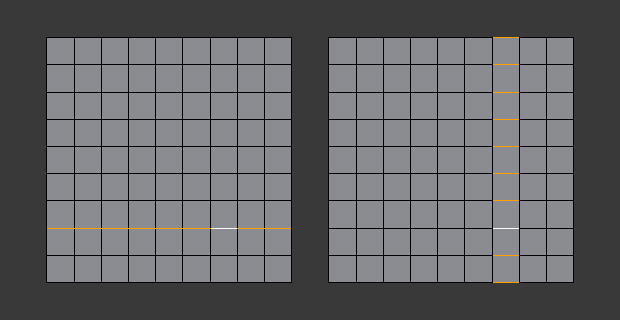
A selected edge loop, and a selected edge ring.
In Fig. A selected edge loop, and a selected edge ring. the same edge was clicked on, but two different “groups of edges” were selected, based on the different tools. One is based on edges during computation and the other is based on faces.
Shortest Path¶
Reference
Ctrl-RMB and the menu item 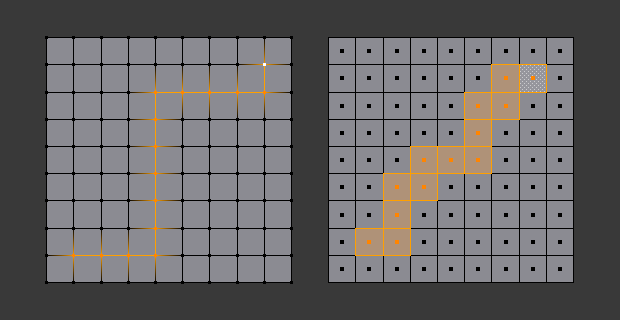
Select a face or vertex path with Ctrl-RMB.
Selects all geometry along the shortest path from the active vertex/edge/face to the one which was selected.
- Face Stepping
- Supports diagonal paths for vertices and faces, and selects edge-rings with edges.
- Topological Distance
- Which only takes into account the number of edges of the path and not the length of the edges to calculate the distances,
- Fill Region
Ctrl-Shift-RMB - Selects all elements in the shortest paths from the active selection to the clicked area.
- Checker Deselect
- See Checker Deselect.
Loop Inner-Region¶
Reference
Select Loop Inner-Region selects all faces that are inside a closed loop of edges. While it is possible to use this operator in Vertex and Face selection modes, results may be unexpected. Note that if the selected loop of edges is not closed, then all connected edges on the mesh will be considered inside the loop.
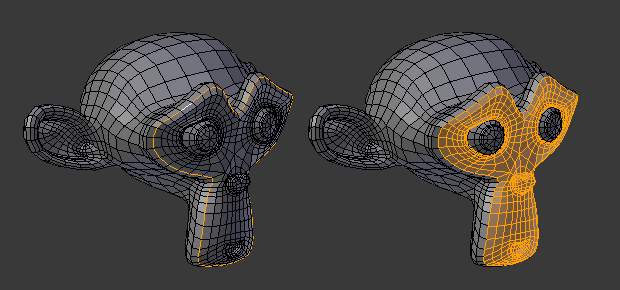
Loop to Region.
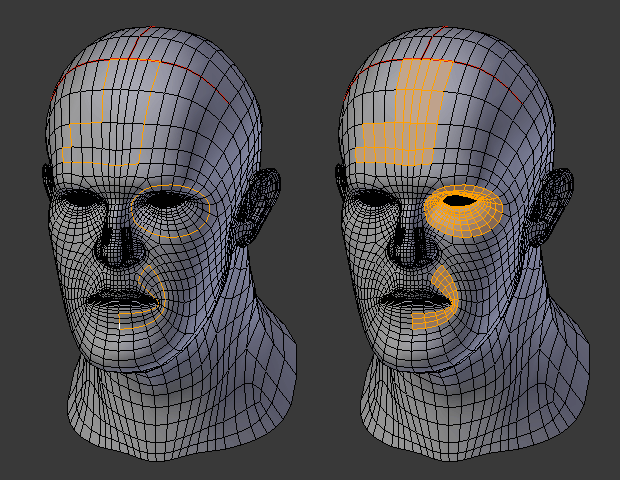
This tool handles multiple loops fine, as you can see.
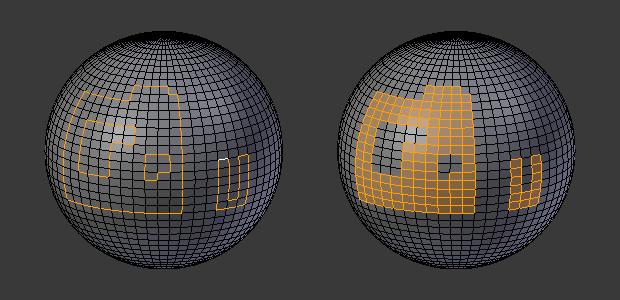
This tool handles “holes” just fine as well.
Boundary Loop¶
Reference
Select Boundary Loop does the opposite of Select Loop Inner-Region, based on all regions currently selected, it selects only the edges at the border(contour) of these islands. It can operate in any select mode, but when in Face mode it will switch to Edge select mode after running.
All this is much more simple to illustrates with examples:
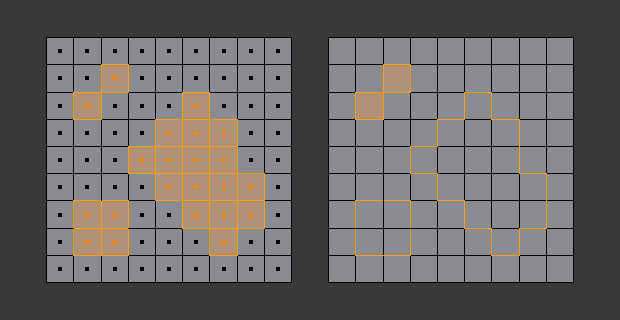
Select Boundary Loop does the opposite and forces into Edge Select Mode.